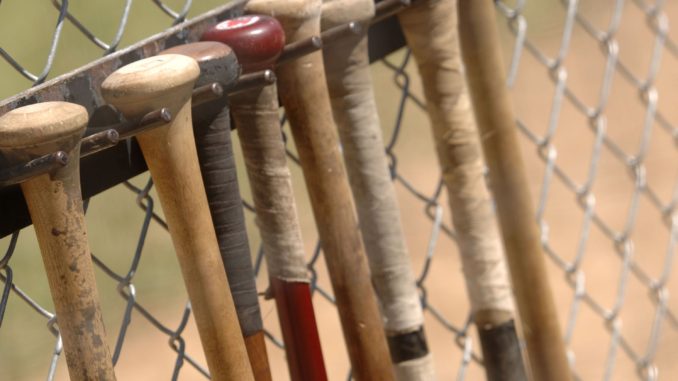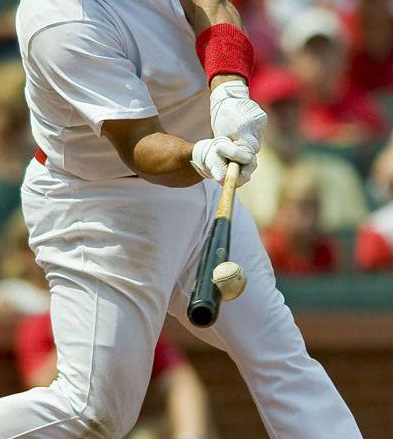
Some wood bat companies are charging $200+ a bat nowadays. Many manufacturers lead players to believe that a superior wood bat will make them a better hitter. For a piece of equipment that will surely break sooner or later, is it worth it? Do you get what you pay for? Judging by the sales of these bats, many players say “yes.” Countless players have told me their theories about how certain company’s bats have more “pop”. Or that maple has more “pop” than ash. Are players on to something with these theories or are they just wasting their money?

When players talk about “pop” off the bat, they are talking about how fast the ball comes off the bat after contact. In physics terms, this is known as the coefficient of restitution. The coefficient of restitution (COR) is the ratio between two objects before and after they collide. For example, if I throw a baseball at a brick wall and it hits the wall at 30 mph and rebounds off the wall at 15 mph, the COR is .5. The simple formula is below:

So if I throw a marble and a rubber superball at at wall, the superball will have a higher coefficient of restitution because it bounces better off the wall. It is important to understand what COR is when it comes to the ball-bat collision. If expensive bats really have more pop, then they should also have a higher COR then cheap bats. If maple bats really have more “pop” than ash, the same should be true. However there is no evidence that this is the case.
Many scientists who study baseball and run experiments on the ball-bat collision, have not found any statistical differences between wood bat species and hitting performance. When it comes to “pop” wood is wood. There are no magic bats that launch the ball better than others. For more information read the works of Dr. Alan Nathan, baseball physics expert (check out his great website here) , Robert Adair author of “The Physics of Baseball” and Professor Lloyd V. Smith.
Let me explain why the wood bat type does not matter. When a baseball and wood bat collide the ball compresses significantly and then rapidly expands back to its original spherical shape as it explodes off the bat. Wooden bats do not compress much at all. However metal bats do. Metal bats are not solid like wood. They have a hollow barrel and this allows the wall of the bat to compress, which creates a “trampoline effect” to launch balls a little harder. That is one reason why metal bats do in fact have more “pop” than wood.

Being that wood bats are solid and don’t compress much, the ball hitting the bat is very similar to a ball hitting a hard wall. The bat does not add any significant energy to the ball by compressing. Even though there are slight variations to wood hardness, all wood species seem to react the same during the ball-bat collision. The differences between wood types is not large enough to matter and the COR’s are virtually the same.
So should you buy the cheapest bat you can find, because all bats perform the same? No, because there are other factors that affect the bats performance besides the coefficient of restitution. Durability, density of the wood and shape of the bat are all important. Typically the cheapest bats you can find are made with the worst wood. Wood that has uneven grain spacing and doesn’t have straight grains, is going to be less durable. If you are spending money on a bat you want it to last for many hits.
A bat’s durability is not an exact science. The skill of the hitter plays a major factor as well. A hitter who connects with the ball on the sweet spot consistently is going to break less bats than a hitter who is always getting jammed or hitting the end of the bat. Some bats may look like they are made from great quality wood but have some inner imperfections that you can’t see and break almost immediately. I have seen some really nice expensive bats break on the first swing and I have seen some $20 bats last for months. There is clearly an element of luck when it comes to bat durability.
Different types of wood can have a different density. This, along with the shape or model of the bat can affect the feel of the bat, which could affect the bat-speed and the momentum of the bat at contact. So when selecting a bat, a hitter should look for a model of bat that optimizes bat speed and weight. However once a hitter finds a type of wood, size and model of bat that they perform best with, they can buy the bat from any manufacturer. As long as the bat is made to the same specifications, it should perform the same.

So should you spend a lot of money on wood bats? No, I don’t think so. Really expensive wood bats are not worth it. All wood performs the same when it contacts the ball. So your biggest concern should be finding a bat that is the best size, weight, length, shape and material for you to consistently hit the ball as hard as you can. Quality of the wood should also be a concern, however there are many smaller manufacturers that produce really good quality bats for $40-75 dollars each. Don’t be tricked into paying extra for the big brand names.
That being said, expensive bats are usually very nice quality bats and if you can afford them, then go for it. For some people buying an expensive bat gives them a confidence boost. The placebo effect is a real thing and the hitters who really believe that certain bats have more “pop,” I won’t argue with them. However, everyone else should know that there are much cheaper options available.
